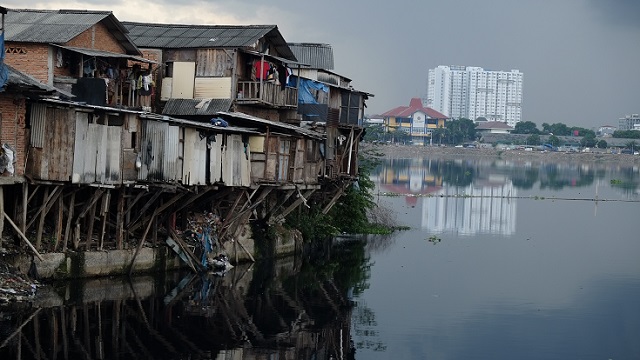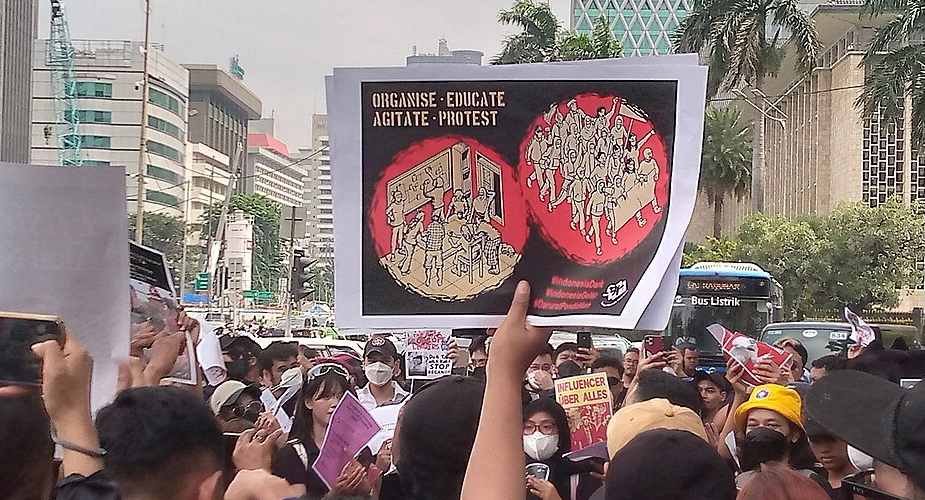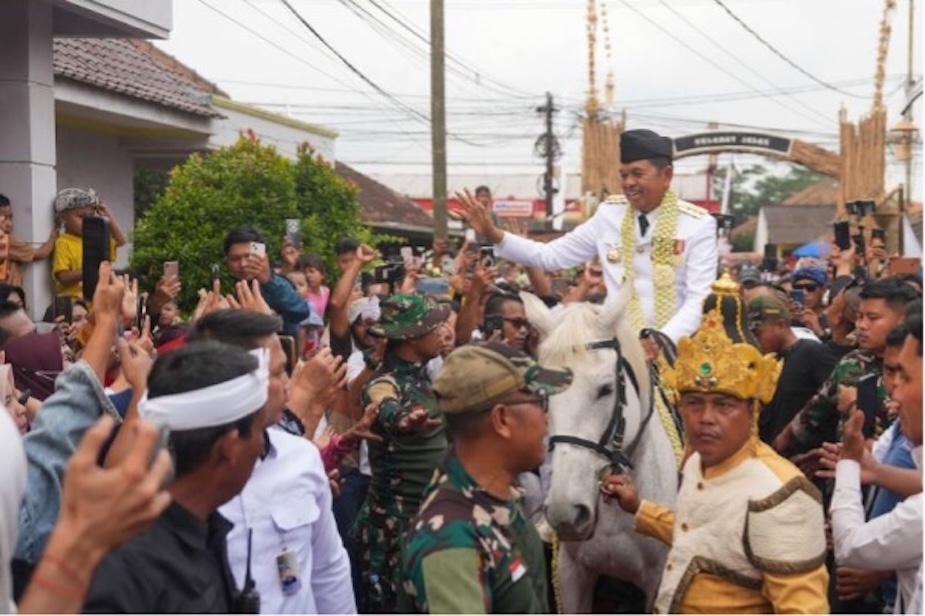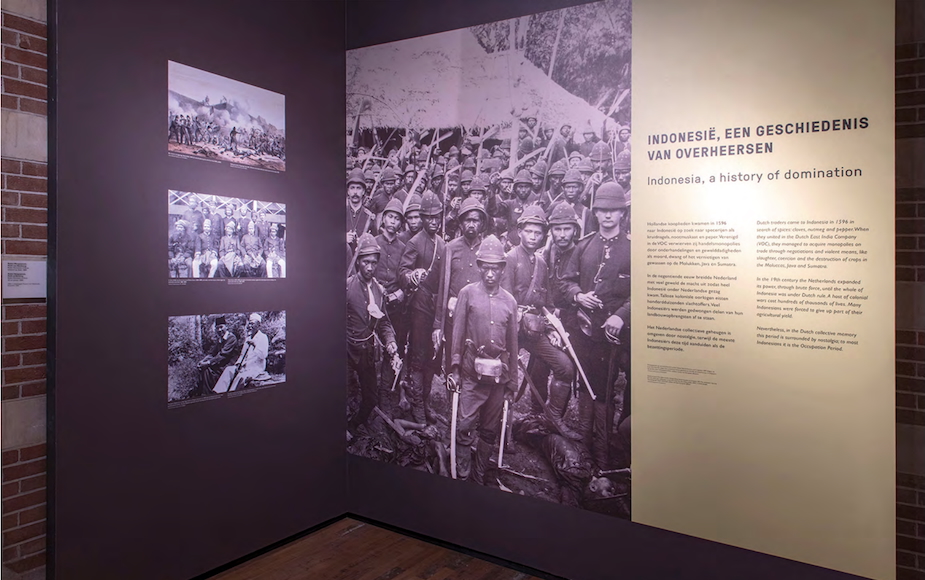For Jakarta’s most vulnerable, vertical social housing creates more problems than it solves
Versi Bhs Indonesia
Sri grimaced with pain as she hauled the five-gallon containers off her makeshift trolley. For the past year she’s scraped together a living delivering drinking water up and down the stairs in her five storey rusunawa (social housing apartment block) where she lives with her family in Jakarta’s east. Tap water is not drinkable, and there is no lift in the apartment, so tenants are happy to pay her to do it. At 55 years old, it’s a far cry from the early retirement she had enjoyed renting out modest rooms in her old neighbourhood of Pasar Ikan. Despite living there for several decades, Sri and her family were labelled illegal squatters by former governor Basuki Tjahaja Purnama, as part of a wave of evictions to make way for public works and commercial developments. In April 2016 they, and hundreds of others, were evicted at such short notice there was little time to gather more than a handful of possessions before the bulldozers came in. Sri and her family had few options other than to accept the government’s offer of a social housing apartment over 30 kilometres away in Rawa Bebek.
With an unserviceable bank debt, loss of income and lack of alternatives, Sri is now forced into back-breaking labour.
It has become a common refrain from city planners and government officials that the future of housing in Jakarta is ‘vertical’. Ever increasing population pressures in Indonesia’s megacity capital and the scarcity and rising price of available land twinned with a developer-driven oversupply of luxury housing and shopping malls, have placed immense pressure on Jakarta’s poorer, residential areas. Once a city in part defined by its sprawling heterogeneous neighbourhoods in which people of different backgrounds worked, lived and interacted in relative close proximity, urban space in Jakarta is increasingly divided and segregated according to wealth and class.
The move towards more vertical living arrangements in multi-storey apartment blocks is in many respects a pragmatic response to Jakarta’s congestion. It has, however, distinct and diverse implications for how people live, particularly for the poor. Many have shared a similar fate to Sri, as in the over 25,000 social housing apartments in Jakarta, close to 80 per cent of residents are victims of eviction and forced relocation. In the past 10 years, most of these social housing apartments have been built in the city’s outskirts.

Jakarta's rusunawa are built far from the city centre / Ian Wilson
Poverty, going up
Advocates argue that social housing apartments for the poor constitutes a social, economic, and even moral solution for secure and affordable housing. They also laud it as a humane response to illegal and informal land occupation in the city. But the experience of many evictees, however, has been one of increased economic hardship, social alienation, further marginalisation and the denial of basic rights.
From our surveys of residents in several of these apartments, we found that an overwhelming majority of evictees experienced a significant drop in income post-relocation, in some cases for years. There was a more than 60 per cent increase in the number of people earning less than Rp.3 million, which is significantly below the Jakarta minimum wage of Rp.3.6 million. The reasons for this are in many respects inherent in the location, design and management of the apartments. Subsidised social housing models in Jakarta assume residents will have regular income to pay for rent and utility costs. Overwhelmingly, however, they rely on income from a variety of irregular sources such as informal labour and small-scale entrepreneurship to make ends meet. Their income stream is unpredictable or, as in the case of Sri, is inextricably linked to their former home and neighbourhood, which is now demolished.
The sorts of income generation that many of these residents have relied upon to survive are either not available locally, prohibited by management, or inaccessible due to distance. Home-based vending or food stalls, for example, which were previously a stable source of income in their old neighbourhoods, are forbidden from operation in individual apartments. The apartment blocks’ ground floors commonly have limited space for small-scale enterprise, and even then renting one of the small number of permanent kiosks is prohibitively expensive. Isolation of the apartments from surrounding neighbourhoods or other hubs of economic activity also means that customers are largely limited to apartment residents. Distance from these locations also means that getting access to paid work is harder. For example, Marunda, Jakarta’s largest social housing apartment complex, is situated in a swampy coastal area that is also sparsely populated.
Other forms of livelihood are also prohibited because they do not conform with the government’s preferred image of rusunawa as places of cleanliness and order. Pemulung (trash recyclers), who are an important component of Jakarta’s waste management system, are banned from keeping their rubbish carts in the apartment compound. According to apartment management, doing so is ‘too untidy’. But despite such undermining of established sources of income, little has been offered in the way of alternatives to compensate for the loss. There are government-run ‘economic empowerment’ programs for apartment residents, such as sewing or batik making classes, but they have largely failed to translate into sustainable incomes for the simple fact that there is no local demand.
At the same time as livelihood opportunities have decreased, daily expenses for basic goods such as rice and cooking oil have increased due to the lack of affordable local options. The distance to low-cost food markets is often too great, and the irregularity of public transport services in some of these areas means there is a greater need for private vehicles to get around. This situation has caused debt levels to rise as residents borrow to make ends meet. As one resident recounted ‘Everyone lives on credit here. For food, for transport, for rent, for everything. It’s a loan shark’s paradise’. Such high levels of debt help to explain why over 43 per cent of apartment residents have experienced rental arrears to the point where management threatened them with eviction.
The loss of access to livelihood and affordable goods and services is further aggravated by inflated utility costs, such as water and electricity, which are installed individually in each unit. The bills are paid individually too, differing from old set-ups that allowed a single connection to be shared by several families. One resident in Rawa Bebek, where Sri also lives, said that since being relocated she only ironed her husband and children’s uniforms when necessary as a result of the higher cost of electricity, adding that they ‘just have to get used to wearing untidy clothes’.

Adjusting to new ways of life?
The apartments’ material infrastructure also imposes distinct sets of social constraints on daily life, which the residents often struggle to negotiate. Apartments are designed for an idealised nuclear family, consisting of one small room for parents and the other for their children with no possibility of expansion or modification. In some instances this has forced families to fracture and separate. Visits by extended family are also strictly regulated and monitored, particularly after Lebaran, the Muslim celebration following the holy fasting month. Typically, the festival is a time when relatives from the regions visit the capital, and some do so with the intention to stay on and find work. During Lebaran, apartment staff place large banners in front of the buildings to remind residents that it is forbidden for relatives to stay, and also conduct frequent spot checks on residents suspected of breaking the rule.
Further complicating things, the apartments operate like ‘depoliticised’ spaces, with management prohibiting social organisations, such as ethnic or religious associations, advocacy groups or branches of political parties. Residents recounted apartment staff’s suspicion towards these collective gatherings, including life cycle rituals. In Rawa Bebek, for example, the funeral ceremony for a child who had fallen to his death was prohibited because it could become ‘politicised’. The grieving family ended up being forced to hold the funeral on a dusty side street.
These prohibitions on social organising and the lack of communal spaces have resulted in what many residents describe as a significant reduction in social interaction and solidarity. One resident described how ‘When people come home here, they close their doors rather than keep them open. I never realised I could feel so lonely despite being surrounded by people until I moved here’.
The absence of lifts also creates physical challenges and dangers for the vulnerable, such as older residents, people with disabilities, pregnant women or those with small children. Rather than a needs-based placement system, however, management exploits the desirability of lower floor apartments, which are rented at a higher rate. This creates new literal hierarchies among the already disadvantaged.
A solution for whom?
The end result is that the poor are forced into living arrangements that are hostile to the social networks, organisations, and opportunities that are crucial for everyday survival. In this way, rather than mitigate poverty and social marginalisation, this form of social housing concentrates, compounds and punitively manages these social issues.
Rusunawa apartments are simply not a sustainable solution to these problems for the poor. Rather, many are more akin to temporary shelters or warehouses for those required to make way for state infrastructure and market-driven developments, such as the gentrification of Jakarta’s coastal districts or the clearing of historical riverside communities as part of flood mitigation programs. This helps to explain why basic factors, such as accessibility to work and affordable services, have largely been overlooked in apartment design and location, despite critical input from urban planners and advocacy from urban poor groups.
Ian Wilson (iwilson@murdoch.edu.au) is a lecturer in Politics and Security Studies, and a research fellow in the Asia Research Centre at Murdoch University.
Amalinda Savirani (lindasavirani@yahoo.com) is a lecturer in the Department of Politics and Government at Gadjah Mada University.















